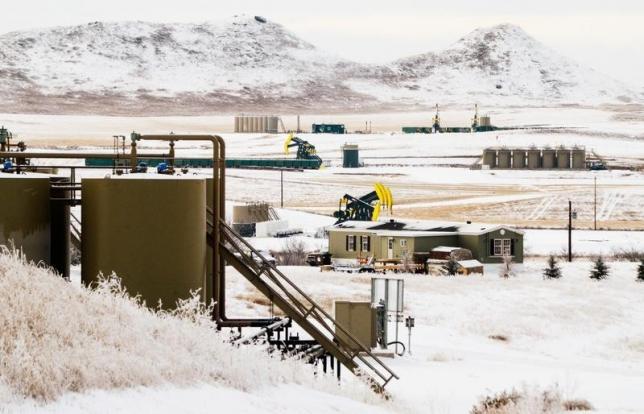
Pumpjacks and other infrastructure for producing oil dot fields outside of Watford City, North Dakota January 21, 2016. REUTERS/Andrew Cullen
Oil prices rose on Friday, recovering more than 25 percent from 12-year slumps hit last week and paring losses for the month, forecasting a deal between major exporters to cut production and curb one of the biggest supply gluts in history.
Also, oil drew support from steadier stock markets, boosted by weak U.S. gross domestic product growth data that raised expectations that the Federal Reserve may impede any planned interest rate hikes.
The oil market rallied for four straight sessions after the Organization of the Petroleum Exporting Countries’s renewed call for joint efforts with competing producers to cut supply instigated a stream of comments from Russia on a deal with the cartel, something it had been rejecting to do for 15 years.
Brent March futures, which expired on Friday, closed at $34.74 a barrel, 85 cents or 2.5 percent higher. On Jan. 20, it hit $27.10, its lowest since November 2003.
U.S. crude settled up 40 cents or 1.2 percent, at $33.62 per barrel, having reached a high of $34.40 in the session.
For the week, Brent was 7.9 percent higher and U.S. crude 4.4 percent higher, cutting their monthly losses to 6.8 percent and 9.3 percent respectively.
However, after the Wall Street Journal cited an Iranian oil official as saying the country would not join an immediate OPEC production cut, both contracts briefly turned negative.
Moscow has sent mixed signals, eventually saying veteran minister Sergei Lavrov, who almost never comments on oil policies, would visit the UAE and Oman to discuss oil markets.
Additionally, cash-strapped Venezuela is also sending its oil minister to Russia on a tour beginning on Saturday of non-OPEC and fellow OPEC states.
“The market has rewarded these statements about the possibility of a deal, even though I think it’s ridiculous,” said John Kilduff, partner at Again Capital LLC in New York.
Other analysts said prices may have found a bottom and could rally as high as $45 by year-end as non-OPEC supply is reduced and global demand improves.
For the second straight month, U.S. oil production fell in November and U.S. shale producers, who have facilitated adding to the glut, have reduced 2016 capital spending plans more than expected.
Meanwhile, oil services company Baker Hughes Inc said that the U.S. oil drilling rig count fell for the sixth straight week with more cuts seen.
“With more energy companies announcing cuts and OPEC contemplating a cut, it looks like oil is forming a bottom,” said Phil Flynn, an analyst at Price Futures Group in Chicago.
“Now the question becomes how high can they go. The charts look like a test near $40 is on the cards.”
For the second straight week, and as a sign of the market sentiment improvement, hedge funds raised their bullish bets on U.S. crude oil the U.S. Commodity Futures Trading Commission (CFTC) said.
“It’s something that sub-$30 oil does. It makes some traders inclined to think that we are have reached or are near a bottom, so they want to be positioned ahead of it,” said Gene McGillian, Senior Analyst at Tradition Energy in Stamford Connecticut.
